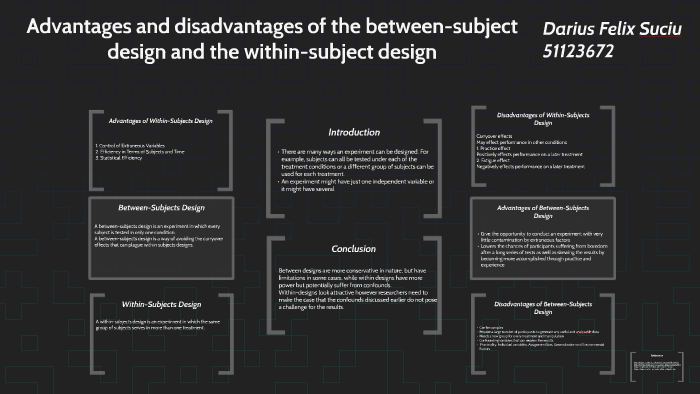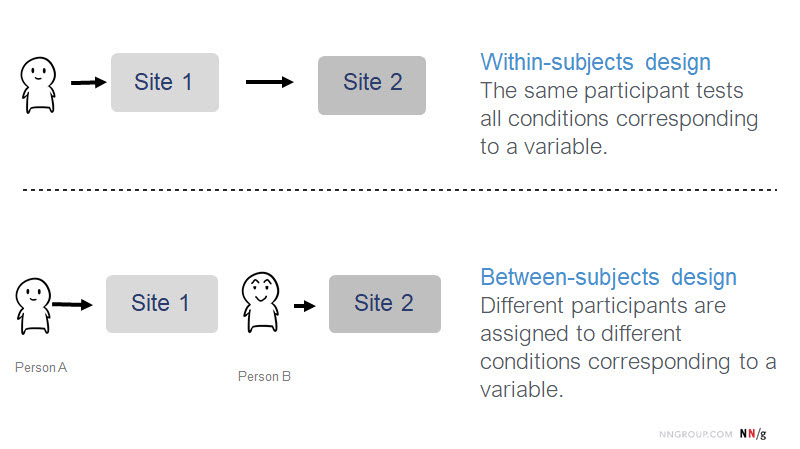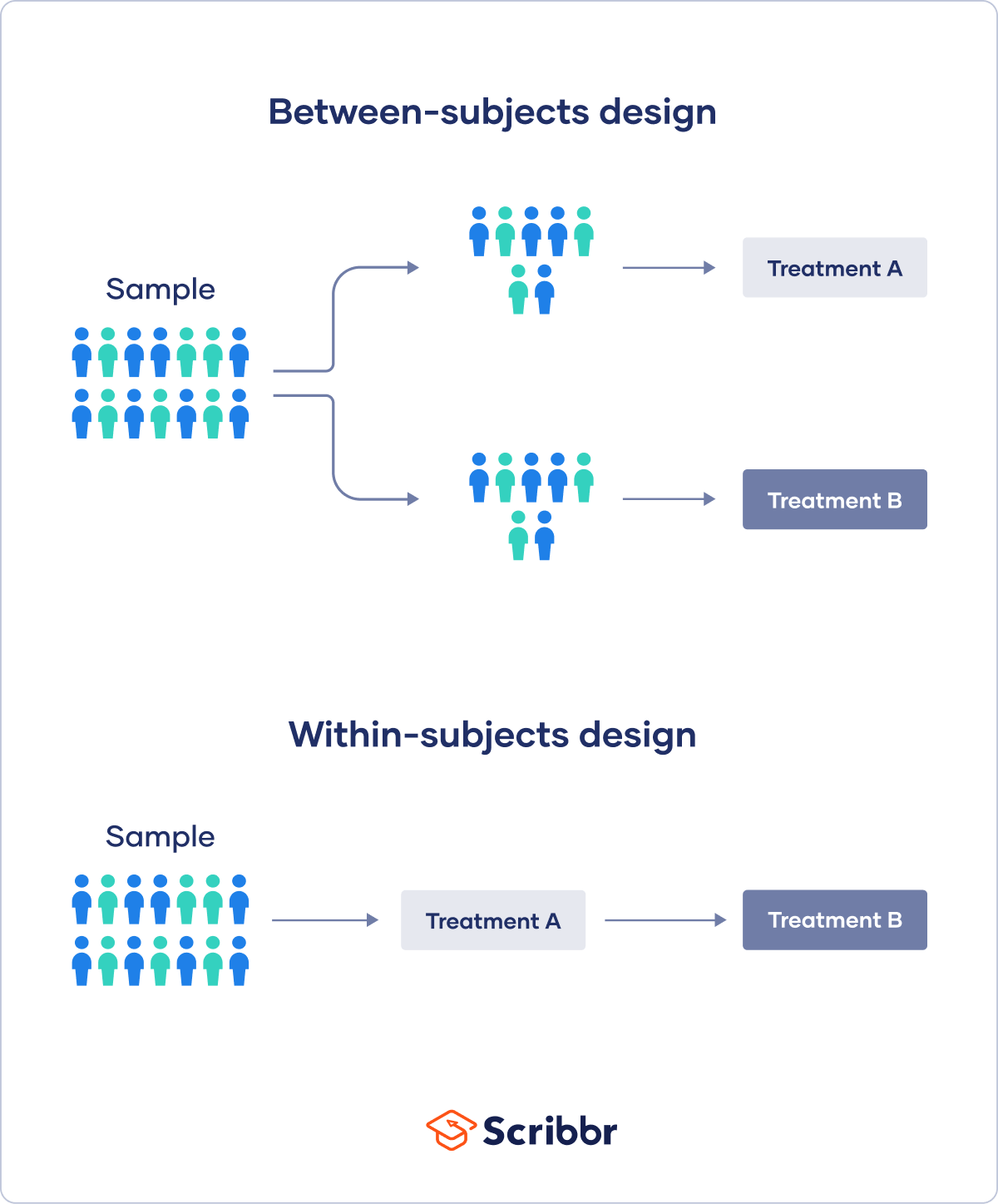Disadvantages of a between subject design. Within-subjects designs have greater statistical power than between-subjects designs meaning that you need fewer participants in your study in order to find statistically significant effects.

Advantages And Disadvantages Of The Between Subject Design A By Darius Suciu
Disadvantages of random assignment.

. Require large number of participants as each participant gives only one score. Correspondingly what are the advantages of a between subjects design. This is a common design used in psychology and other social science fields.
Prevents carryover effects of learning and fatigue. The same holds true for most other person variables like race sex age and so on. A between-subjects design is an experiment in which every subject is tested in only one condition.
Experts are tested by Chegg as specialists in their subject area. What are some of the advantages of a between-subjects design. Who are the experts.
Perhaps the most important advantage of within - subject designs is that they make it less likely that a real difference that exists between your conditions will stay undetected or be covered by random noise. Between-subjects designs are more. Disadvantages of Between Subjects Design.
We explore the merits and weaknesses of between-subjects and within-subjects designs in experimental work. Each person is only measured once so they researcher can be confident that is not contaminated by other factors. Individual score is independent of other scores.
For example the between-subjects version of a standard t-test requires a sample size of 128 to achieve a power of 80 whereas the within-subjects version only requires a sample size of 34. These designs do not control all extraneous variables to the same degree however. Can be used for a wide variety of research questionshypothesis any experiment comparing twomore treatment conditions.
This is the best answer based on feedback and ratings. Discuss some of the advantages of using a between-subjects design. Discuss some of the advantages of using a between-subjects design.
Advantages of a between subjects design. Researchers testing educational programs for example might need two groups of twenty children for a control and test group. Describe how a second factor can be used to reduce the variance in a between-subjects experiment.
Why is it an advantage to use a between-subjects design instead of a within-subjects design. It allows each individual score to be independent of all other scores It can be used to address a wide variety of questions. At its most basic level this design requires a treatment condition and a control.
The utilization of the between-group experimental design has several advantages. Advantage of a between subjects design why it is called an independent measures design each score is separate from the other ones. Does not guarantee perfectly balanced outcomes.
Subjects moods for example can still differ from one condition to the next. A group of researchers wants to test some modifications to the educational program and decide upon. Between-Subjects Design 1 A between-subjects design is an experiment in which every subject is tested in only one condition.
Use your real-world example to explain in detail how the example you provided fits the design selected for that example two-way between-subjects. Compared to within-subjects studies between-subjects studies have shorter testing sessions. With between-subjects studies theres no chance to run into a transfer of knowledge issue since each test participant is assigned a different user interface to test.
Name the advantages and disadvantages as a method for limiting individual difference effects. We review their content and use your feedback to keep the quality high. The sessions are shorter.
The other problem is that. A between-subjects design is a way of avoiding the carryover effects that can plague within subjects designs. Advantages of Between-Subjects Design.
Summarize the advantages and disadvantages of each from a statistical and practical perspective and provide a real-world example of an experiment and design for the two-way factorial ANOVA. Individual participants bring in to the test. Control of Extraneous Variables.
We describe experiments in economics and in psychology that make comparisons using either of these designs or both that sometimes yield the same results and sometimes do not. First multiple variables or multiple levels of a variable can be tested simultaneously and with enough testing subjects a large number can be tested. Between-Subjects Experimental Design Between-subjects 123456789 123456789 123456789 Between-subjects Factors Unchangeable variables Practice effects Long studies AdvantagesStudy unchangeable variablesAvoid practice effectsAvoid effects of fatigue or boredomAvoid cueing the participants to the objective of the studyTakes less time for each.
Between-subjects is a type of experimental design in which the subjects of an experiment are assigned to different conditions with each subject experiencing only one of the experimental conditions. Fair and unbiased easy to perform doesnt require measure or direct control of extraneous variables.

Between Subjects Vs Within Subjects Study Design

Psy 250 Chapter 9 Within Designs Within Subjects

Ppt Within Subjects Design Powerpoint Presentation Free Download Id 9439434

Experimental Design Between And Within Factors Psych 231 Research Methods In Psychology Ppt Download

Between Subjects Design Examples Pros Cons

Between Subjects Design Independent Groups Design

Basics Of Experimentation 1 Experimental Design Which To Choose And Why Ppt Download

0 komentar
Posting Komentar